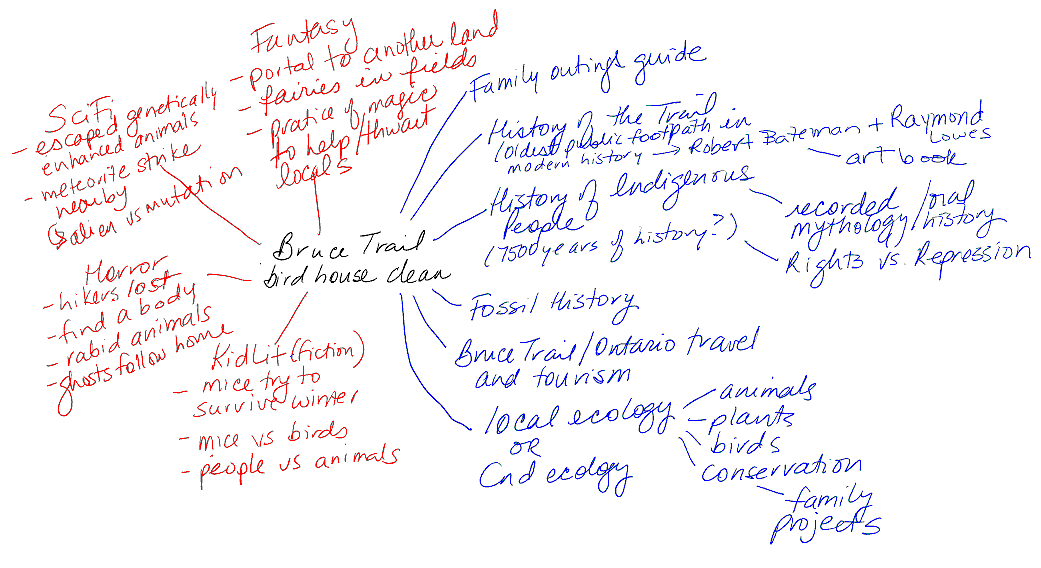
How to Find a Story – Your Story!
Adventure and quietude are two environments in which I find story. You might think they are polar opposites but they’re more like layers of a cake. When icing and sponge alternate, the entire cake tells a delectable story.
Ideas to Find Story Abound
Some people have told me that it’s easy for them to find an interesting story idea when they’re on holiday, or doing something that feels exciting, but no so much during the day to day moments. Quietude is a blessing for a writer, because then you can be alone with your thoughts.
Here’s an example. Yesterday, I went with my son’s Cub Scout group on an excursion along the Bruce Trail. We helped a local conservation group clean out and prepare boxes for nesting wild birds. A pretty low key day, right? Well, not when we came across a family of mice living in the bird box! One scurried through the hole while the others peeked at the kids from the access panel, each set of beady eyes wondering why the big, ugly humans were destroying their penthouse.
If we consider that excursion the “adventure,” then I could use the household quiet of son and husband being out of the house to find story ideas from that adventure. A couple of hours on the Trail provide a wealth of fodder for fictional and non-fictional content, across several genres. I’ve written a few of them out in the image below. Of course, there are hundreds of possibilities, but I have to keep on track!

Shh! I’m Exploring
Quietude, itself, is a source of inspiration. Consider an item in your home. It is a “thing” that’s connected to the history of it being invented, the person/persons who patented it, the people who made it, the culture that orchestrated a need for it, and the impact the item has on the world at large. Nothing exists in isolation. Ask yourself the best question you could ask: what if?
“Button, Button” by Richard Matheson asks the question, “What if you’d receive $50 000 very time you pushed a button, but someone had to die?” The story inspired a Twilight Zone episode by the same name, and a movie with a very different outcomes called “The Box.” I don’t know what inspired him, but the short story’s central object is a button – the kind that might be on a game show, held within a glass-domed box. When seen through a creative lens, every day objects hold worlds of wonderment.
Creating alternate history is a great way to find story. What if Queen Victoria and Prince Albert had never married? They created a concept of “family life” in response to the rising demand for industrialism. Would England have evolved a psychology of workers first, family second? Then what would happen to our modern concept of family if a family’s only purpose was to generate more workers for the industrial force?
The Best Ideas Arise From Refining Ingredients
This diagram represents proverbial tip of the iceberg to find story and create a working manuscript. Take the idea of a History of Indigenous People who have lived along the Bruce Trail. As the creator of the manuscript, the next step is to figure out what interests you most, and how you personally figure into that book. Do you identify with the Indigenous cultures, or are you a supportive outsider? If you don’t involve Indigenous People in its creation, nor support the culture with your product, you may be culturally appropriating. Are you going to tell the story of one person, or one family, or are you going to make broader strokes that reach back into the thousands of years of Indigenous history? Non-fiction books have a “story” to tell, whether in creative non-fiction narrative or in the presentation of hard facts.
The deeper dig the fictional side includes tropes you want to use or avoid, the conflict in your story, character arcs, and all that other lovely jazz that makes creative writing so much fun to write (and read!). Consider what kind of story you want to tell, “happily ever after,” grimdark, romantic, scary, or family friendly. Throw all your ideas down and see what resonates with you. What theme keeps coming up and what do you want to do with it? Play with your story structure. Does a non-linear tale work better? Whose point of view should you use? Who is the best narrator?
Find Story First, Bake it Next!
I could spend – correction, I do spend, hours brainstorming. Whether I’m coming up with new content, problem solving myself out of a narrative dilemma, or responding to an editor’s critique, I put a lot of though into what I write. Yep, hours of wondrous, no-pressure, “I could daydream all day and forget to get dressed in the morning” thoughts.
Discovering ideas without applying them in a productive way won’t launch anyone’s book or business idea. Sure, someone, somewhere may be willing to pay a lot of money for an idea person who doesn’t create an end product, but I don’t have that kind of employer on my contact list. If you do, share it?
Both adventure and quietude are necessary for that perfect idea, just as icing and sponge are for a cake. However, much as writers and authors need to allow themselves the freedom to find story ideas everywhere around them, they also need to make the choice to do something with it. That’s where so many people get caught – in the procrastination of creation. Next week, I’ll talk about how to get out of that rut and turn the story you found into your quality product!